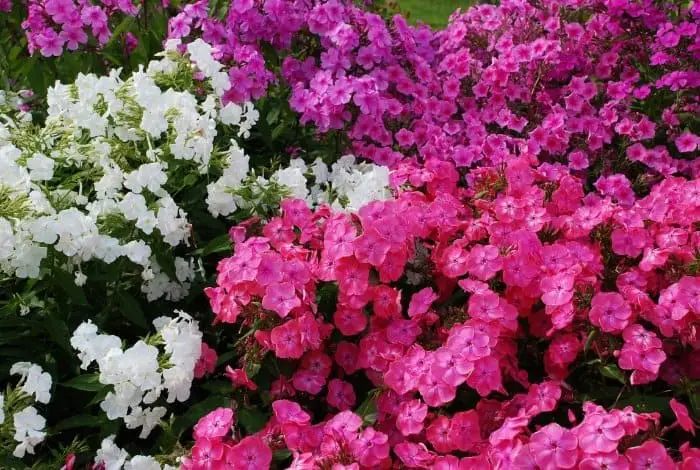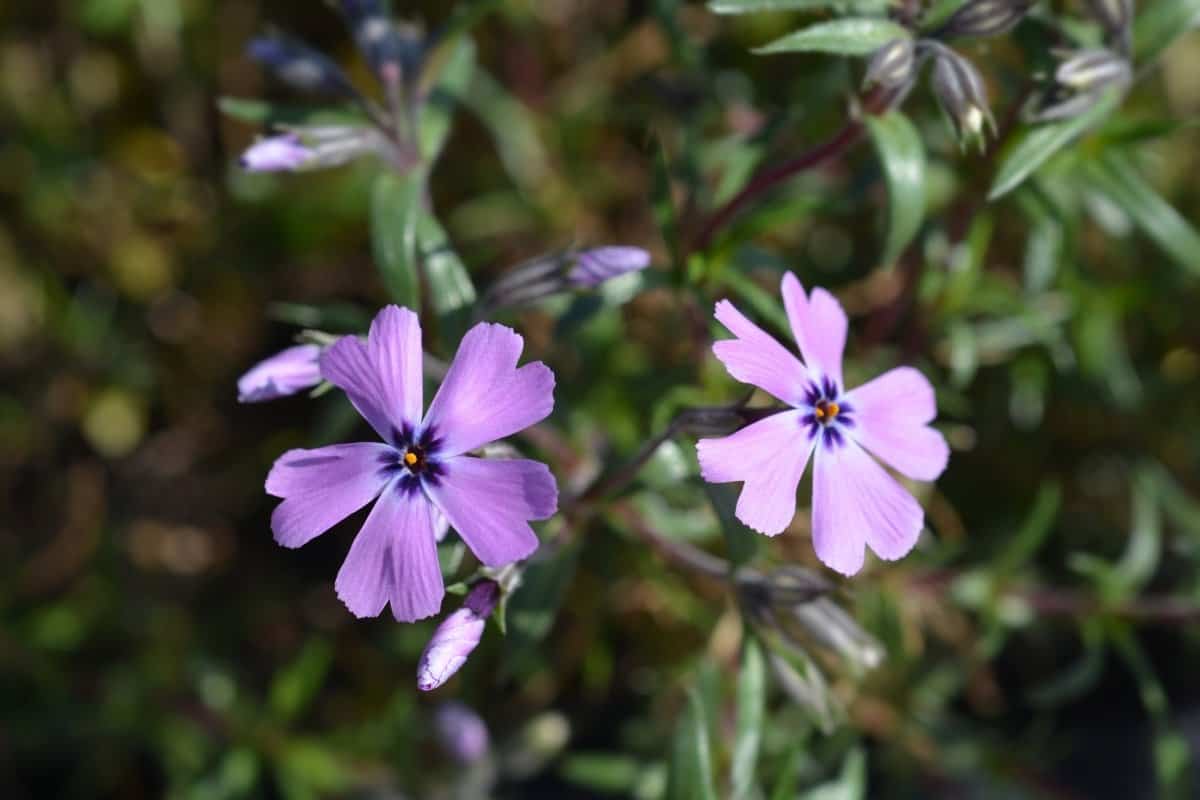Last Updated on February 3, 2023 by Griselda M.
Knowing when does creeping phlox blooms and what to expect will afford you a lush flowering garden. Does Creeping phlox bloom all summer or winter, or in what season do they flower and display their array of beauty?
Phlox has been a favorite flower for many years. It comes in a variety of types many of which are native to North America and is found almost in every garden. These plants feature start-shaped colorful flowers when in bloom.
Their versatility cannot be understated as each type represents something as shown below
- Low-growing or creeping phlox works excellent as ground cover
- Tall phlox is excellent for a colorful backdrop
- Medium-height varieties fill in any gaps that need some kind of beauty
These flowers are low maintenance and have a lovely fragrance than any other flower. The tall phlox or the Paniculata Phlox is seen growing across yards of many abandoned old houses or spread across roadsides.
What Does Creeping Phlox Look like When Not in Bloom?
If you’re wondering what creeping phlox look like when not in bloom, then let me enlighten you. These easy-to-grow fragrant flowering plants are quite attractive whether they are in bloom or not. During the spring season, you will get to see the beauty of their flowers as it is the time of year when they are in full bloom.
Their shaded flowers come in an array of colors which include white, purple, blue, and pink. However, when these plants are not in bloom, they are still quite an eye-catching garden beauty. Without flowers, they show off their needle-like bright green foliage, which is known to enhance the look of any landscape.
So, a phlox not flowering shouldn’t really be a worry, especially when it comes to the extent to which they beautify your yard without their candy-colored blooms.
Creeping Phlox Light Requirements
When it comes to creeping phlox light requirements, there are a few things that you should keep in mind. These plants, although hardy, grow to their full potential when afforded full sunlight. Although creeping phlox plants can tolerate partially shaded light, to get exceptional blooms, full sun is recommended. Keep in mind that if these plants are grown in the right conditions, they will eventually become well-established and able to grow healthily in the case of drought.
However, to reach this stage, creeping phlox plant care and maintenance are vital. Seeing that the phlox plant does well in soil with efficient drainage properties, planting them on slopes will enhance the growing mediums’ capabilities. So, to ensure fully flowered phlox plants through the blooming season, it is best to plant them away from large trees that will block direct sunlight. Monitoring when does creeping phlox blooms should be an important plant of your plant care implementations.
What to Do with Phlox After Flowering?
So, you have creeping phlox plants in your garden and are wondering what to do with phlox after flowering. After flowering, it is essential to deadhead your phlox plant. The reason that this is recommended is that it will enhance the plant’s appearance and neaten it up. Thereafter, in the coming autumn or winter seasons, it is best to cut your phlox plants down to ground level, which will accelerate spring growth.
Keep in mind that the process of deadheading your phlox plants may also afford them side shoots during the autumn season. This is actually a bonus if it occurs. In areas where winter cold fronts arrive later in the season, it is best to deadhead early. This will then allow for the phlox plant to grow and develop full flower heads by the end of the summer.
Although there are sterile phlox cultivar varieties that don’t really require this type of pruning, you must know that deadheading them will result in a much more attractive array of flowers. During this time, you can also fertilize your phlox plants and if you’re lucky enough, you could be surprised with a second flush of dainty blooms. For these reasons, knowing when does creeping phlox blooms will keep you a step ahead with your plant maintenance strategies.
Creeping Phlox Bloom Time
Phox are perennials and a favorite choice for many gardeners. The creeping phlox covers the ground well and blooms in spring and the early part of summer. The tall phlox blooms in mid to late summer.

Varieties of Phlox that Bloom All Summer and Spring
- Creeping phlox. This is the most common and is planted in many homes. Creeping phlox is called so because it grows close to the ground, crawling and spreading. It blooms approximately 6 weeks into the spring and the early part of summer in all the zones it grows. You can propagate it by transplanting portions to the areas where you wish to grow it. It grows slowly taking a long time to fill a large space.
- Tall Phlox. This variety grows anywhere from 10 inches to 4 feet high. Tall phlox blooms in summer that is July and August. There are exceptions of tall phlox that do not bloom in summer. Astoria and Intensia phlox bloom beautifully into late fall and through winter in very cold climates. Astoria grows up to about 24 inches and Intensia reaches around 14 inches tall.
When and Where to Plant Phlox
Plant phlox immediately after you receive it to avoid damage to sensitive young plants. Plant it either in spring or fall.
Planting in Fall. Plant your phlox a few weeks before your first frost falls. You can keep the plants cool on a deck for a few days until it’s the best time to plant. But do not let the roots dry out before you plant.
Planting in Spring. If your phlox plant arrives in spring, keep it moist in the container until the ground is ready for planting. Hold off the spring planting until the ground is easy to work on and the soil is free from melted snow and ice.
Growing Conditions for Phlox Flower
Phlox is a low-maintenance plant but it requires the right growing conditions to thrive.
- Light. Both varieties of phlox thrive in full sun. The garden phlox requires both sun and a little shade particularly in the south to thrive.
- Soil. Though phlox is tolerant to most garden soils, it does well in well-drained soils, especially in the Northern areas where the snow drains slowly. Waterlogged, damp spring soil can cause root rot in the plants killing them. Use compost or peat moss added to the garden soil to improve drainage and create a better growing environment.
- Spacing. Tall Phlox should be planted about 18 inches apart while creeping phlox planted about 2 feet apart. If you plant them too close they are attacked by mildew. Giving them enough room for air circulation is the cure for mildew.
Once planted in these right growing conditions, you will realize that both varieties will gradually increase and join together to form a large grouping of phlox. The creeping variety creates a carpet or mat-like formation on the ground.
Find out more about beautiful flowers:
Best Phlox Flower for Summer Blooms
If you want to plant phlox that blooms during summer, you will have to settle on the garden phlox. Garden phlox is the only one that blooms during summer. However, there is a disclaimer – not all garden phlox blooms at the same time in summer. They vary depending on the zone and climate they are growing under. It is possible to have the first bloom in early June or as late as late July.
Conclusion
We now have a clear answer to the question does creeping phlox bloom all summer? We know what blooms during summer and what doesn’t. We know what to plant depending on our needs and zone and when to plant it.
Go ahead and plant these darling flowers and make your home bright and beautiful like never before!
FAQs
Is there a creeping phlox that blooms all summer?
Phlox is a perennial flowering plant. It is a genus in the family Polemoniaceae. Creeping phlox are known for their long blooming seasons. They bloom all summer, which also corresponds to their growing season. However, they are not hardy in colder climates and will die in the winter if not brought inside during the winter months.
Creeping phlox blooms from May to September but usually only one at a time with white or light pink flowers that are only about 1 cm wide.
Creeping phlox is one of the most common plants found in Eastern Canada. It loves moist, shady environments and spreads quickly across woodland floors to form carpets of tiny flowers.
How do you keep phlox blooming all summer?
Phlox needs at least six hours of sun in order to bloom. Keep in mind that the blooms will be more intense if they are getting full, indirect sunlight. If you want to get more blooms during the hotter months, water them every morning and evening.
The best way to get phlox to bloom all summer long is to plant them in groups of three or more and water them regularly.
There are many ways to keep phlox blooming all summer long.
The first thing you should do to keep your phlox blooming all summer is fertilize them once every year by using fertilizer that is specific for perennials. You can use organic or chemical fertilizer, whichever you prefer. The next thing you should do is plant the phlox in well-draining soil so the roots do not rot and the plants will be healthier overall. The last thing you can do to keep your phlox alive for longer periods of time is to water them regularly, but not too much so they don't get root rot or other diseases.
Caroline is a gardener who loves to get down to the nitty–gritty of gardening. She proudly proclaims herself as a ‘dirt worshipper‘ and can often be found deep in the garden, covered in soil and singing to her plants. As a self–proclaimed ‘plant whisperer‘, Caroline believes that plants need love and attention just like any other living thing, and she loves to give them both. When she‘s not tending to her garden, you can often find her researching the latest gardening trends, or teaching others how to make their gardens thrive



